How Long Does a Baby Goose Stay in the Incubator?
Nada production
The main egg-laying period for geese is in the spring, commencing nearly August or September. Chinese breeds tin can first laying in wintertime. Encourage early seasonal egg production, so goslings are of marketable historic period and weight in time for the Christmas market.
- Fertility will be up to xv% higher and hatch-power upward to twenty% higher with mature female geese than with 1-year-quondam geese.
- As geese normally lay in the morning, collect eggs late in the morn to reduce the risk of egg breakages, and collect eggs at least four times a day.
- Considering nearly eggs are laid early in the morning, it is all-time non to give geese access to swimming facilities until later in the morning time, otherwise eggs may exist lost. Equally mentioned earlier, swimming improves the status of geese generally and helps to go along them clean, which in turn helps to keep eggs make clean.
- Geese usually lay a clutch of 12–15 eggs and then become broody.
Early onset of egg production can exist encouraged past the following:
- Genetic choice and cross-breeding. Chinese breeds are ameliorate egg producers than Toulouse or Emden breeds, but their smaller body is a disadvantage. Cantankerous-breeding the Chinese breed with either Toulouse or Emden produces breeding stock of acceptable egg production and carcase.
- Utilize of bogus lite. This volition induce early onset of egg production, as it does in laying hens (come across Primefact 604 – Lighting of poultry).
- Improved nutrition. Put geese in broody coops as before long every bit they become broody. If geese are immune to remain broody without being checked, egg production will exist seriously affected.
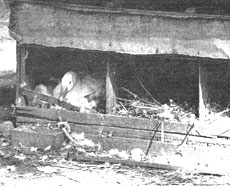
To reduce the incidence of egg breakages, provide nest boxes (shown at correct) and encourage their apply for laying. Line them with suitable nesting textile, such as shavings or straw, and allow one l cm × l cm nest box for every three geese in the flock. It is best to have nest boxes in the shed and throughout the 1000 if big yards are used.
Incubation
Natural incubation produces the best percent of goslings hatched. Using geese to hatch out their own goslings is expensive and wasteful, since geese are non laying while they are sitting on the eggs. Turkeys, hens and Muscovy ducks may be used satisfactorily to hatch out goslings — best results volition be obtained from Muscovy ducks (which are really geese). Goose eggs can be hatched artificially, just results are meliorate if Muscovies are used.
- Eggs should be collected at to the lowest degree twice (preferably four times) daily, and, equally geese lay most of their eggs in the morning, the bulk of the eggs will exist collected in the morn.
- Eggs for incubation should be stored in a cool room at 15°C — an airconditioned or refrigerated chiffonier is ideal. Turn eggs daily (see Table 1). The longer the eggs are kept over 7 days, the poorer the hatching results.
- Select simply uncracked eggs weighing at least 140 g and no more than 200 yard. Clean those eggs that are dirty by lightly rubbing with steel wool and wiping with a make clean clammy cloth. Eggs will need to be handled and stored in this mode regardless of the method of incubation.
- Eggs tin can be disinfected by fumigating them immediately afterwards collection.
- The actual period of incubation of goose eggs varies slightly with the brood. Some eggs from the lighter breeds may showtime pipping after 28 days, while eggs from the larger breeds may take 35 days. It may take up to 3 days for hatching to be completed.
Natural incubation
Depending on the size of the bird, 4–6 eggs may be placed under a broody hen whilst a Muscovy duck may sit on vi–viii eggs. Since the eggs are likewise large for most hens to plough by themselves, turn the eggs by hand daily when the hens leave the nest to eat and drink. Subsequently 15 days, eggs should be sprinkled with lukewarm water each time they are turned.
Candling, that is, passing eggs under a bright electric light to view the contents, tin be carried out on the 10th day and all infertile eggs removed.
Where a goose is to exist used for hatching out the eggs, 10–fifteen eggs may be placed under her (the number of eggs depends on the size of the eggs and the size of the goose). If geese have admission to swimming facilities, the eggs demand not be sprinkled with water.
Artificial incubation
Unless machines are properly managed, goose eggs practise not hatch very well in artificial incubators. Hatches frequently are no better than twoscore% of the eggs set up, even though fertility is about 90%. This is considering of poor management and because incubators available in Australia are not manufactured specifically for geese.
With forced-draught machines, maintain a constant temperature of 37.5°C throughout the incubation period. The desired humidity volition exist obtained if the moisture bulb thermometer is kept at a reading of 32.2°C to the 29th day. Then increase information technology to 34°C for the remainder of the incubation time, using moisture trays and adjusting the ventilation.
Incubators with a slow air movement over the eggs volition hatch goose eggs ameliorate than those with a fast air movement. Slow air movement ensures complete distribution of air over all parts of the egg to maintain uniform and equal evaporation.
Experiments in France, using 2000 eggs in xviii incubators, have substantiated the demand to place eggs horizontally (come across Table ane).
| Blazon of egg | Hatch-ability | ||||
|---|---|---|---|---|---|
| Eggs gear up on pointed stop | Eggs fix horizontally | ||||
| Turnover bending | Turnover angle | ||||
| 90° | 120° | 90° | 120° | 180° | |
| All eggs ready | 49.0% | 66.vi% | 69.ii% | 69.8% | 69.2% |
| Fertile eggs | 64.0% | 85.three% | 86.2% | 88.9% | 89.4% |
* Artigueres Enquiry Centre, France
In the incubator:
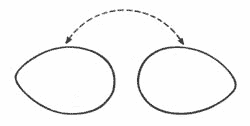
- Best results are obtained if eggs are turned over completely at to the lowest degree four times daily, that is, through an angle of 180° (as shown in the diagram at right) and not 90° equally with craven eggs. Best hatching results are obtained if eggs are set horizontally.
- Eggs must be spaced evenly throughout the incubator if the auto is not full. The temperature of the machine should be 0.two°C higher when the machine is less than 60% full.
- Because goose eggs require high humidity, they should be sprinkled daily with warm h2o. After the 15th day of incubation, eggs should be completely submerged every second day in water kept at a temperature of 37.5°C and and then daily in the last week of incubation, for 1 minute. Alternatively, fine nozzles that spray water at 37.v°C when needed can be installed in the incubator.
In the hatcher:
- Eggs should be transferred to the hatcher on the 27th day of incubation unless feel shows eggs are hatching at less than 30 days of age.
- Eggs should be dipped or sprinkled with water, as previously described, only one time afterwards they are transferred.
- Temperature in the hatching compartment should exist kept at 37°C and relative humidity at most 80%. Later on the peak of the hatch, reduce to 36.5°C and 70% humidity.
- Leave goslings in the hatcher for two–4 hours after the hatch is completed, then transfer them to the brooders.
Cleaning the incubator
Thoroughly clean and sanitise all incubator trays and incubators when not in use. Fumigate incubators with formaldehyde gas which is produced by combining formalin with potassium permanganate (Condy'due south crystals). Note: A respiration mask fitted with a suitable gas cartridge filter should be used in the presence of formaldehyde.
To fumigate the incubator:
- Turn off the motor.
- Place the required amount of potassium permanganate in an earthenware container on the floor of the incubator and pour over it the required corporeality of formalin (25 thou of potassium permanganate and 35 mL of formalin (40%) are enough to fumigate 1.0 g3 of incubator infinite).
- Allow the machine to run for at least 10 minutes at the normal operating temperature and maximum humidity with the incubator door airtight.
- To forestall operators beingness overcome by formaldehyde fumes, open the doors and windows of the incubator room to provide ventilation before opening the incubators.
Sex identification of geese
The sex of twenty-four hour period-old goslings can exist identified in a similar manner to that used for chickens, by examining the vent. Sexing of solar day-olds is best left to a qualified chicken sexer, equally an inexperienced person may damage the sexual organs.
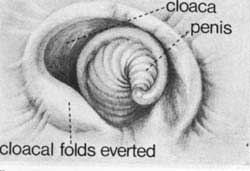
With experience, day-old goslings can be identified by belongings the legs firmly between the first and second fingers of the left mitt, with the neck between the third and fourth fingers and the breast away from you. Then press gently with the left thumb on the abdomen while at the same time pressing down on the tail with the thumb and forefinger of the right paw. Exercise this quickly to remove the contents of the bowel, making examination easier.
The vent is so everted by pressing gently downwards on the abdomen with the pollex of the left hand about the vent. Simultaneously place the first finger and thumb of the right hand close together on the opposite side of the vent and slowly separate with a gentle but house pressing motion, stretching and everting the cloaca to expose the penis if the gosling is male.
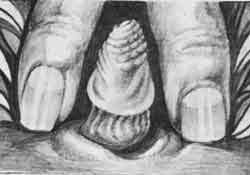
Mature birds (that is, birds over the age of 7 months) tin be identified by physical examination. The identification is made easier if two people are available. 1 method of exposing the penis is past pushing back the tail towards the head with one hand and exerting a steady downward pressure on the abdomen with the other.
The vent will then exist everted and the organ exposed. The penis, spiral shaped and white, is only over 1 cm long in immature birds but upward to 4 cm long in mature ganders. The colour of the area inside the gander'due south vent is pinkish and the surface is polish.
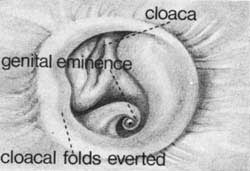
The illustrations of the exposed reproductive organs of an immature male person, a mature male person and a maturing female will aid in sexual activity identification:
It is difficult to distinguish the sex of growing goslings and mature birds other than by examining for the presence of the male'due south penis. The characteristics listed in Table two may as well aid y'all to distinguish sexes:
| Gander | Goose |
|---|---|
|
|
Marking birds according to their sex using leg bands, web punching, or wing bands.
Source: https://www.dpi.nsw.gov.au/animals-and-livestock/poultry-and-birds/species/geese-raising/egg-production
0 Response to "How Long Does a Baby Goose Stay in the Incubator?"
Publicar un comentario